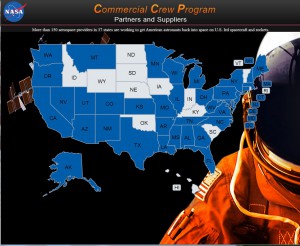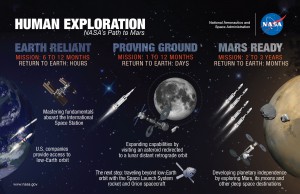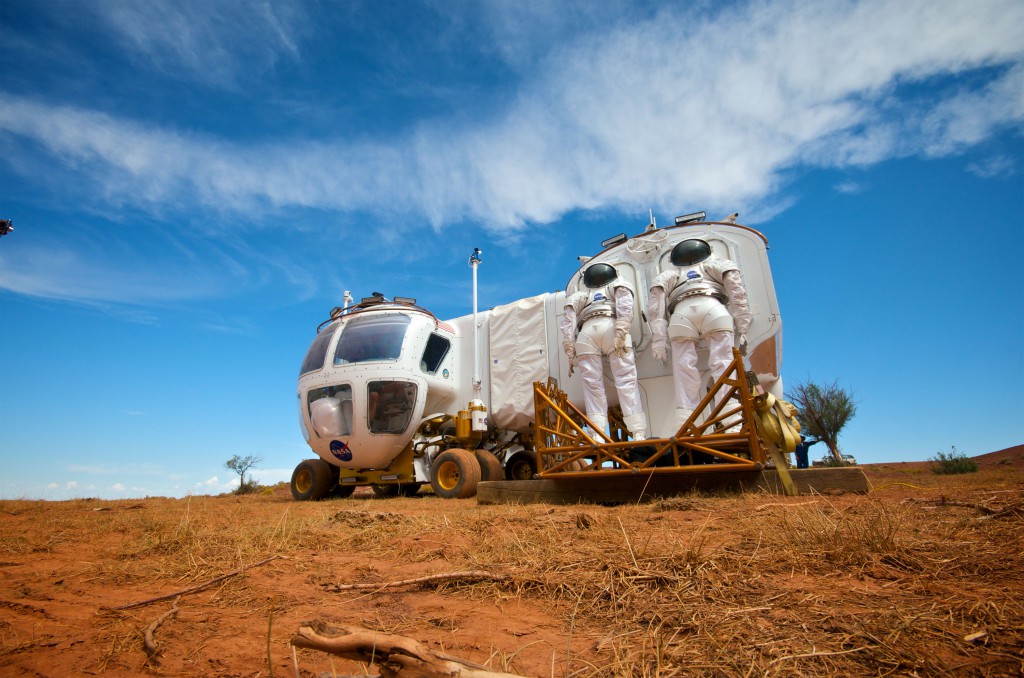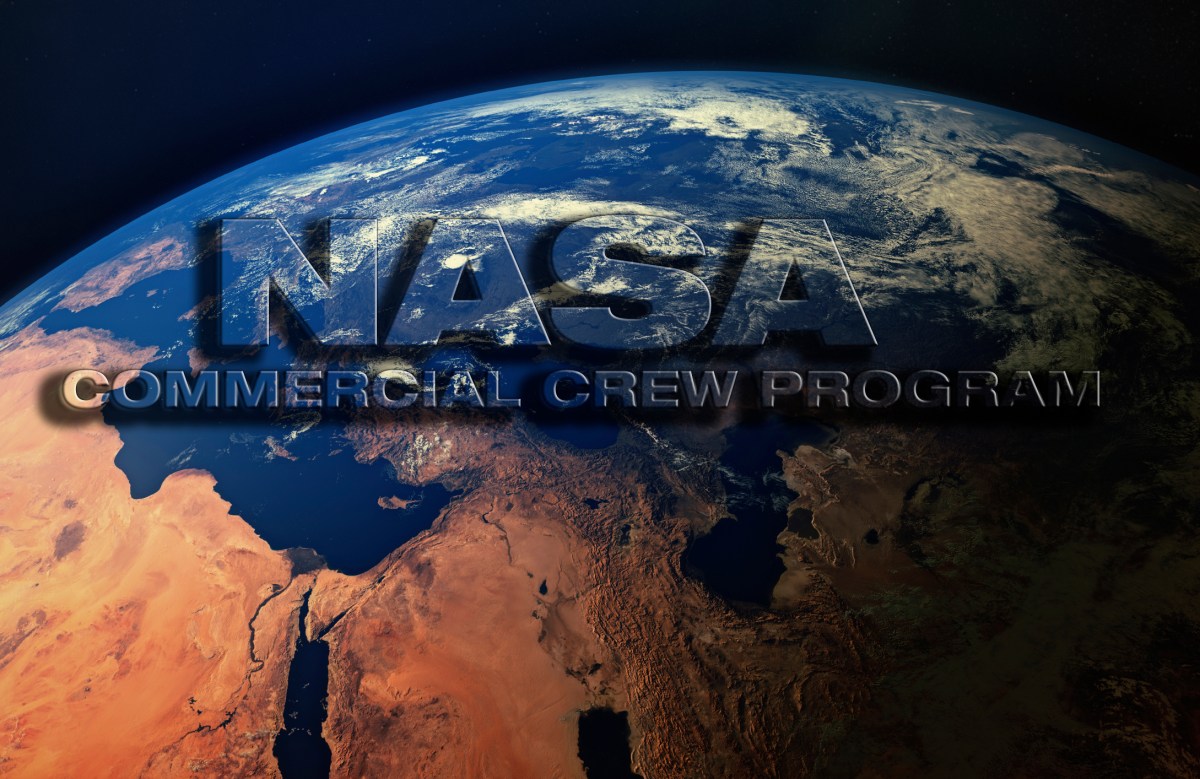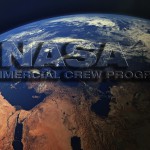Want to see who is contributing to the Commercial Crew Program effort? There are now more than 150 companies working in 37 states supporting the Commercial Crew Program partners as they continue to develop and certify their systems that will support crew transportation to low-Earth orbit.
Art of the Spacesuit
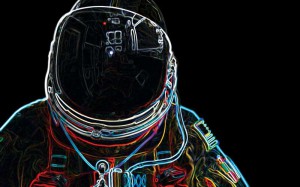
The modern spacesuit can do a lot of things a full spacecraft can do, though for not nearly as long. Providing oxygen to breath, plus cool and warm air for comfort, a space suit serves in many ways as a personal spacecraft. It also acts as a storage bin of sorts, with pockets all over the garment to hold tools, notes and the occasional family photo. Some of NASA’s aerospace industry partners are designing suits to handle their needs. NASA teams are working on the robust designs that will keep astronauts safe and healthy during walks along the Martian surface.
With a new era of advanced spacecraft on the horizon, what would you like to see in a spacesuit you put on? What memento would you absolutely have to take with you stuffed in a pocket?
What Would You Do On Mars?
NASA’s human exploration pathway leads to Mars. Our Commercial Crew Program is just the beginning, and the new Mars 2020 rover is one of the upcoming steps, but think about that finish line today and consider what you would do if you landed on the Red Planet. What Mars features would you want to explore? What would you hope to discover? What might you leave behind? What would you bring home?
What would you take with you – aside from oxygen, water and radiation protection? Because Mars is as far away as it is, a mission would last two to three years, with several months on the surface, so there’ll be lots of time before packing up and heading back to Earth. Are you going to look out the window or is there an exploration or construction project on your mind? If you need some help kick-starting your mind on these aspects, have a look at our Mars site and note the pic below of experimental set-ups being tried out in Earth environments with an eye toward crew needs on Mars.
NASA Partners Punctuate Summer with Spacecraft Development Advances
Spacecraft and rocket development is on pace this summer for NASA’s aerospace industry partners for the agency’s Commercial Crew Program as they progress through systems testing, review boards and quarterly sessions under their Space Act Agreements with the agency.
NASA engineers and specialists continue their review of the progress as the agency and partners move ahead with plans to develop the first American spacecraft designed to carry people into space since the space shuttle.
“Our partners are making great progress as they refine their systems for safe, reliable and cost-effective spaceflight,” said Kathy Lueders, manager of NASA’s Commercial Crew Program. “It is extremely impressive to hear and see the interchange between the company and NASA engineering teams as they delve into the very details of the systems that help assure the safety of passengers.”
Apollo 11@45: Liftoff to Inspiration
 Arguably, no single event did more to inspire people around the world than the first moon landing by the crew of Apollo 11. This includes numerous astronauts, NASA engineers, and contractors inspired to go through rigorous scientific and engineering academic tracts after sitting in the living room of their house as children watching the fuzzy black-and-white image of Neil Armstrong move down the ladder of the lunar module and take humanity’s first steps onto another world.
Arguably, no single event did more to inspire people around the world than the first moon landing by the crew of Apollo 11. This includes numerous astronauts, NASA engineers, and contractors inspired to go through rigorous scientific and engineering academic tracts after sitting in the living room of their house as children watching the fuzzy black-and-white image of Neil Armstrong move down the ladder of the lunar module and take humanity’s first steps onto another world.
That mission lifted off from Kennedy Space Center 45 years ago this morning with the moon landing and first steps taken four days later. (You can watch NASA’s launch videos here)
Mike Good, a veteran astronaut who works with the Commercial Crew Program and whose missions include spacewalks to repair NASA’s Hubble Space Telescope, put it this way when asked why he became an astronaut:
“I certainly remember as a little kid being influenced and inspired by the landing on the moon. I was 7 years old and watched it on a black-and-white TV in my living room. Like all the kids and everybody else, I thought that it was pretty cool. Then as I worked through school and got into college, I became interested in engineering. I made the decision to go into aerospace engineering in 1981, which was the first year that the space shuttle flew, so that definitely had an influence on me, too. I watched that and said, ‘You know, this is something that I’d like to be a part of.’ I didn’t necessarily think I was going to be an astronaut, but it was an industry that I wanted to be in. After college I went on to fly for the Air Force, and I was able to put the flying and engineering together, which are two things that I liked to do. After flying fighters for a while, I got to go through the Air Force’s test pilot school, which is really where you get to test new airplanes and weapons systems. From there, it was just kind of a natural progression to work toward the astronaut program. I put in a couple applications and finally got a call to come join.”
The Brains of the Countdown
Every mission into space, whether carrying a crew or lofting a satellite or probe, is overseen by a collection of specialists who make sure everything is A-OK with the rocket and spacecraft through liftoff, ascent and beyond. At NASA’s Kennedy Space Center in Florida, the Launch Control Center was the space agency’s answer to the gargantuan demands of processing and testing the Saturn V rockets and Apollo spacecraft that would carry astronauts to the moon. The aerospace industry partners of NASA’s Commercial Crew Program will use control centers based on the unique needs of their systems and the capabilities of today’s computers and automation. With the 45th anniversary of Apollo 11’s liftoff from Kennedy tomorrow, here’s a look at what went into designing, building and operating the LCC.
Throwback Thursday – A Flag Awaits
 This American flag was taken to the International Space Station in 2011 on STS-135, the final mission of the space shuttle. Flown on the first space shuttle mission in 1981, the flag is to be awarded to the first crew of astronauts to launch from U.S. soil to the orbiting laboratory. NASA’s Commercial Crew Program is working with aerospace partners to make that flight happen by the end of 2017.
This American flag was taken to the International Space Station in 2011 on STS-135, the final mission of the space shuttle. Flown on the first space shuttle mission in 1981, the flag is to be awarded to the first crew of astronauts to launch from U.S. soil to the orbiting laboratory. NASA’s Commercial Crew Program is working with aerospace partners to make that flight happen by the end of 2017.
What Equipment Would Your Spacecraft Have?
The Apollo astronauts took a rover with them to the moon so they could survey more of the lunar surface. The space shuttle used its robotic arm to perform numerous functions from operating experiments to grabbing satellites including the Hubble Space Telescope for repairs to maneuvering large modules into place during construction of the International Space Station. NASA’s next generation of human-carrying spacecraft are in development now. If it were up to you, what equipment would you include in the design and what would you use it for?
Spaceport Magazine Features CCP Partners
NASA’s Commercial Crew Program partners are featured in the new edition of Kennedy Space Center’s Spaceport Magazine posted July 1. You can read the online magazine at the ISSUU digital newsstand or download the pdf.
NASA Veteran Inspired by Destiny that ‘Lies Above Us’
 Jon Cowart, an engineer with a pioneering spirit and more than three decades of human spaceflight experience, recently was honored by NASA’s Astronaut Corps. Learn more about Cowart and his Silver Snoopy award at http://go.nasa.gov/VD2zdS.
Jon Cowart, an engineer with a pioneering spirit and more than three decades of human spaceflight experience, recently was honored by NASA’s Astronaut Corps. Learn more about Cowart and his Silver Snoopy award at http://go.nasa.gov/VD2zdS.
You also can check out the outspoken engineer’s 2012 TEDx event called “A Retrospective on the Future of Space Exploration.”

